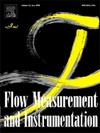采用多模型方法对包括半圆柱闸在内的水闸流量系数进行了估算
IF 2.3
3区 工程技术
Q2 ENGINEERING, MECHANICAL
引用次数: 0
摘要
带半圆柱形底梁的水闸是灌溉渠中用于调节水位和流量的流量控制结构。要估计通过这些结构的流量,必须准确地估计流量系数。本研究的目的是提出一种基于数据挖掘的新方法,在实验数据的基础上准确估计Cd。首先,开发了人工神经网络(ANN)和高斯过程回归(GPR)等独立数据挖掘模型。然后,为了提高独立模型的性能,采用多模型(MM)策略开发由人工神经网络(MM-ANN)和探地雷达(MM-GPR)处理的新的多模型。其次,提出了集成模型(EM)策略。共进行了107次试验,研究了半圆柱形基台几何形状对流量系数的影响。70%的数据留给训练阶段,剩下的30%留给测试阶段。输入变量为能头与基宽之比(h/b)和接近能头与湿化参数之比(h/P),输出变量为流量系数(Cd)。使用统计指标(R2、RE%、RMSE和MAE)和图形工具(Taylor、Violin、RE%和散点图)将多模型和集成模型的结果与独立方法进行比较。MM-ANN模型的准确率优于ANN、GPR、MM-GPR和EM模型,R = 0.951, R2 = 0.904, SI = 0.012, RE% = 0.891, MAE = 0.005, RMSE = 0.007。h/p变量对MM-ANN目标变量的影响最大,SHAP值为0.45。MM-ANN模型对实验结果进行了合理的估计。为了提高该领域模型的计算精度,建议采用多模型策略。本文章由计算机程序翻译,如有差异,请以英文原文为准。
Estimating discharge coefficient of the sluice gate including, the semi-cylindrical sill utilizing multiple model strategy
Sluice gates with a semi-cylindrical sill are flow control structures that are used in irrigation canals to regulate water level and flow discharge. To estimate the flow discharge through these structures, it is necessary to accurately estimate the discharge coefficient. The aim of this study is to present a new approach based on data-mining to accurately estimate the Cd based on experimental data. First, standalone data-mining models such as Artificial Neural Network (ANN) and Gaussian Process Regression (GPR) were developed. Then, to improve the performance of the standalone models, a multiple model (MM) strategy was used to develop new multiple models handled by ANN (MM-ANN) and GPR (MM-GPR). Next, an ensemble model (EM) strategy was developed. A total of 107 experiments were conducted to investigate the effect of the semi-cylindrical sill geometry on the discharge coefficient. 70 % of the data was reserved for the training phase, and the remaining 30 % for the testing phase. The ratio of energy head to sill width (h/b) and approach energy head to wetted parameter (h/P) were as input variables and the discharge coefficient (Cd) was an output variable. The outcomes of the multiple models and ensemble model were compared to the standalone methods using statistical metrics (R2, RE%, RMSE, and MAE) and graphical tools (Taylor, Violin, RE%, and scatter plots). The MM-ANN model with R = 0.951, R2 = 0.904, SI = 0.012, RE% = 0.891, MAE = 0.005, and RMSE = 0.007 outperformed the ANN, GPR, MM-GPR, and EM models in accuracy. The h/p variable had the greatest effect on the target variable of MM-ANN evidenced by a SHAP value of 0.45. The MM-ANN model provided reasonable estimates the experimental results. It is recommended to implement the multiple model strategy in order to improve the calculation accuracy of the models in this field.
求助全文
通过发布文献求助,成功后即可免费获取论文全文。
去求助
来源期刊

Flow Measurement and Instrumentation
工程技术-工程:机械
CiteScore
4.30
自引率
13.60%
发文量
123
审稿时长
6 months
期刊介绍:
Flow Measurement and Instrumentation is dedicated to disseminating the latest research results on all aspects of flow measurement, in both closed conduits and open channels. The design of flow measurement systems involves a wide variety of multidisciplinary activities including modelling the flow sensor, the fluid flow and the sensor/fluid interactions through the use of computation techniques; the development of advanced transducer systems and their associated signal processing and the laboratory and field assessment of the overall system under ideal and disturbed conditions.
FMI is the essential forum for critical information exchange, and contributions are particularly encouraged in the following areas of interest:
Modelling: the application of mathematical and computational modelling to the interaction of fluid dynamics with flowmeters, including flowmeter behaviour, improved flowmeter design and installation problems. Application of CAD/CAE techniques to flowmeter modelling are eligible.
Design and development: the detailed design of the flowmeter head and/or signal processing aspects of novel flowmeters. Emphasis is given to papers identifying new sensor configurations, multisensor flow measurement systems, non-intrusive flow metering techniques and the application of microelectronic techniques in smart or intelligent systems.
Calibration techniques: including descriptions of new or existing calibration facilities and techniques, calibration data from different flowmeter types, and calibration intercomparison data from different laboratories.
Installation effect data: dealing with the effects of non-ideal flow conditions on flowmeters. Papers combining a theoretical understanding of flowmeter behaviour with experimental work are particularly welcome.
 求助内容:
求助内容: 应助结果提醒方式:
应助结果提醒方式:


